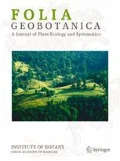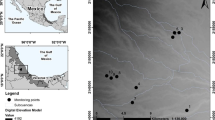Abstract
Patterns of grasslands species mobility were compared between communities and within plant species. Data from high spatial resolution permanent plots with fine scale recording system, experiment with removal of the dominant recorded also at a fine scale were used. The permanent plots showed large variation within a community in the patterns of species mobility. The species mobility was partly dependent on the site and was higher in a more nutrient rich and climatically more favourable community. Mobility also varied within species. In some species (Nardus stricta, Anthoxanthum spp.) it differed between communities (it was higher in more nutrient rich and climatically more favourable community) and did not respond to removal of the dominant species. In another species,Festuca rubra, mobility also differed between plots; in contrast, it did not show consistent variation attributable to community type and showed strongly increased spatial persistence in plots with the dominant species removed. In this species the mobility seems to be dependent on the competitive pressure of the coexisting species.
Similar content being viewed by others
References
Bell A.D. (1984): Dynamic morphology: a contribution to plant population ecology. — In:Dirzo R. &Sarukhán J. [eds.]: Perspectives on plant population biology, Sinauer Assoc., Sunderland, pp. 48–65.
Bengtsson J. (1991): Interspecific competition in metapopulations. — Biol. J. Linn. Soc. 42: 219–237.
Caswell H. &Cohen J.E. (1991): Communities in patchy environments: a model of disturbance, competition and heterogeneity. — In:Kolasa J. &Pickett J.T.A. [eds.]: Ecological heterogeneity, Springer, New York, pp. 97–122.
Crawley M.J. &May R.M. (1987): Population dynamics and plant community structure: competition between annuals and perennials. — J. Theor. Biol. 125: 475–489.
Czárán T. &Bartha S. (1992): Spatiotemporal models of plant populations and communities. — Trends Ecol. Evol. 7: 38–42.
Dixon W.J. (1993): BMDP Statistical Software Manual. — University of California Press, Berkeley.
Grime J.P. (1977): Evidence for existence of three primary strategies in plants and its relevance to ecological and evolutionary theory. — Amer. Natur. 111: 1169–1194.
Herben T., Krahulec F., Hadincová V. &Kovářová M. (1993a): Fine scale spatial dynamics of plant species in a grassland community during six years. — J. Veg. Sci. 4: 171–178.
Herben T., Krahulec F., Hadincová V. &Kovářová M. (1993b): Tiller demography ofFestuca rubra in a mountain grassland: seasonal development, life span and flowering. — Preslia 65: 341–353.
Hogeveg P. et al. (1983): Patterns in vegetation succession, an ecomorphological study. — In:White J. [ed.]: Population structure of vegetation, Handbook of vegetation science, Dr. W. Junk Publ., The Hague, pp. 637–666.
Hutchings M.J. &de Kroon H. (1994): Foraging in plants: the role of morphological plasticity in resource acquisition. — Adv. Ecol. Res. 25: 159–238.
Karlson R.H. (1985): Competitive outgrowth interactions among sessile colonial invertebrates: a comparison of stochastic and phenotypic variation. — Ecol. Modelling 27: 299–312.
Karlson R.H. &Jackson J.B.C. (1981): Competitive networks and community structure: a simulation study. — Ecology 62: 670–678.
Krahulec F. (1990):Nardo-Agrostion communities in the Krkonoše and West Carpathians Mts. — Folia Geobot. Phytotax. 25: 337–347.
Law R., McLellan A. &Mahdi A.S. (1994): Spatiotemporal processes in a calcareous grassland. — Plant Species Biol. 8: 175–193.
Lovett Doust L. (1981): Population dynamics and local specialization in a clonal plantRanunculus repens. I. The dynamics of ramets in contrasting habitats. — J. Ecol. 69: 743–755.
Lovett Doust L. &Lovett Doust J. (1985): The battle strategies of plants. — New Phytol. 95: 81–85.
Palmer M.W. (1994): Variation in species richness: towards a unification of hypotheses. — Folia Geobot. Phytotax. (this volume).
Pielou E.C. (1977): An introduction to mathematical ecology. — J. Wiley, New York.
Schmid B. &Harper J.L. (1985): Clonal growth in grassland perennials. I. Density and pattern dependent competition between plants of different growth forms. — J. Ecol. 73: 793–808.
Silvertown J., Holtier S., Johnson J. &Dale P. (1992): Cellular automaton models of interspecific competition for space: the effect of pattern on process. — J. Ecol. 80: 527–534.
Sykes M., van der Maarel E., Peet R.K. & Willems J.H. (1994): High species mobility in species-rich plant communities: an intercontinental comparison. — Folia Geobot. Phytotax. (this volume).
Turkington R., Sackville Hamilton R. &Gliddon C. (1991): Within population variation in localized and integrated responses ofTrifolium repens to biotically patchy environments. — Oecologia 86: 183–192.
van der Maarel E. &Sykes M. T. (1993): Small scale plant species turnover in a limestone grassland: the carousel model and some comments on the niche concept. — J. Veg. Sci. 4: 179–188.
Author information
Authors and Affiliations
Corresponding author
Rights and permissions
About this article
Cite this article
Herben, T., Krahulec, F., Hadincová, V. et al. Is a grassland community composed of coexisting species with low and high spatial mobility?. Folia geobot. phytotax. 29, 459–468 (1994). https://doi.org/10.1007/BF02883144
Issue Date:
DOI: https://doi.org/10.1007/BF02883144




